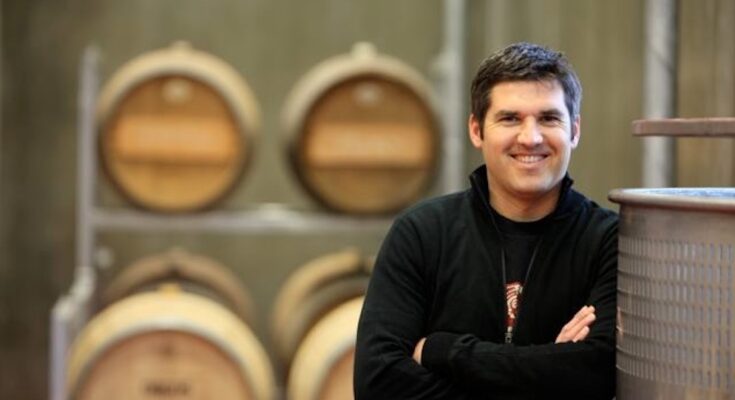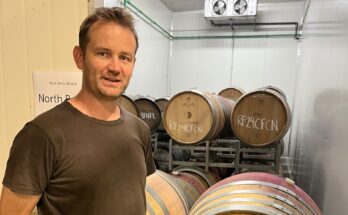I’m a big fan of the rich, generous wines from Bridge Pa fruit, and I’m pleased to make it over to Paritua, one of the mainstays of the region, for a session with Jason Stent, their winemaker at the beginning of December 2020. I’ve been heard to extol the virtues of Cabernet Franc from this part of the world, and Paritua produce one in the Stone Paddock – and one in the Platinum range which is above Paritua. So they actually have three ranges – Stone Paddock, then Paritua and then the black label Platinum range.
A lot of wines from the Bridge Pa triangle seem to be a lot better after a year in bottle – they seem to round out. I often find that wines that are intended to have a bit of character, finesse, even, can be a bit disjointed just after bottling, and at Paritua they try to bottle and then give them six months before sending them anywhere for reviews.
Jason says “I don’t know why that is, because we don’t beat the wines up as much as we used to in the old days. With crossflow filtration it’s one pass, done and dusted in one day, and the usually a day or two later it goes straight to the bottling line. We think it’s the best filtration method we’ve used, and find it doesn’t beat the wines up too much at all. It’s good for Pinot Noir as well”.
I mention that I spoke to winemaker Matt Connell about that – he seems to be the one with the machine that gets used a lot in Central Otago. He’s also quite against ‘whole bunch’ – so we get our teeth into that subject as well.
Jason: “For Pinot, I haven’t really made any for ages. I think 2014 was the last vintage of Central Otago we made.
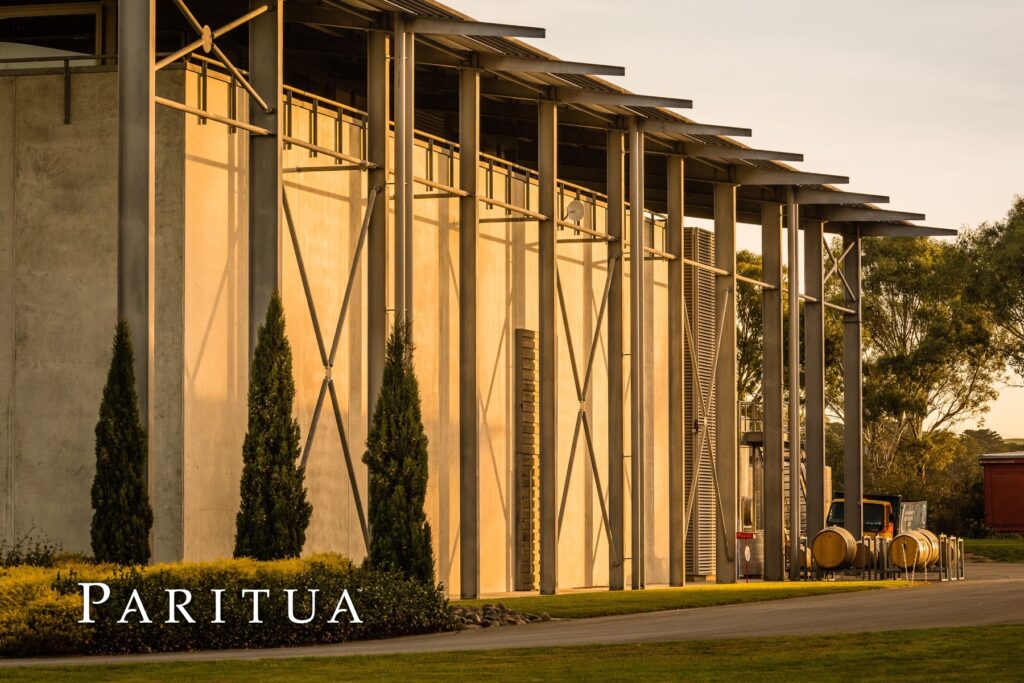
And for Syrah – not off our soils. Mainly because of the clones we have. If we had ‘Mass Selection’ I’d probably look at it, but we have ‘Chave’ and ‘174’. ‘Chave’ seems to naturally have a whole bunch-like character to it – a slight stalkiness and white pepper. And it’s reductive enough, so I don’t really want to make it any more, or polarising. For our wines we’re probably looking for more generosity and aromatics rather than that almost bitter tannin I think you get with stalks. That’s the joy and fun of making wine, you’re always trying things and experimenting.”
Over the past couple of years, I’ve likened it to a balsam, resinous kind of character – a green-black, almost black tea tannin to it. I find it interesting personally, as long as it doesn’t become the wine. We agree that there’s a few Australian wines where they’ve gone 100% whole bunch, and it definitely seems that the pendulum has swung too far in one direction and it needs to come back. Back in the day, Bordeaux used to be a bit like that – it would take a long time to come round.
We start to taste a few wines – starting with Chardonnay (of course, I know..)
Paritua make a couple of Chardonnays. We start with the tank-fermented ‘Stone Paddock Chardonnay’. It’s mostly ‘B-95 clone’ although there is a small portion of ‘Clone 15’ in there too. With the tank-fermented they will use a lot of lees stirring while it is in tank, trying to increase the richness. The bunches of B-95 tend to be very consistent in size, and the same with the berries, so you end up with quite a broad Chardonnay. I’d say that it is probably the perfect clone for making a bubbly. It’s got a richness and not just a pure fruit-driven style.
We also taste the 2019 ‘Paritua Chardonnay’, which is 100% barrel fermented – about 90% in puncheons and then a few barrels – mostly ‘Clone 15’ which is basically Mendoza without the virus. Not a huge amount of this wine is made. In the past Paritua sold a lot of the white grapes off because they are predominantly a red wine brand, and a lot of their wine was going to only one or two markets. Only making what could be sold in New Zealand and the US. But things change, and are picking up now as a really good distributor comes on board.
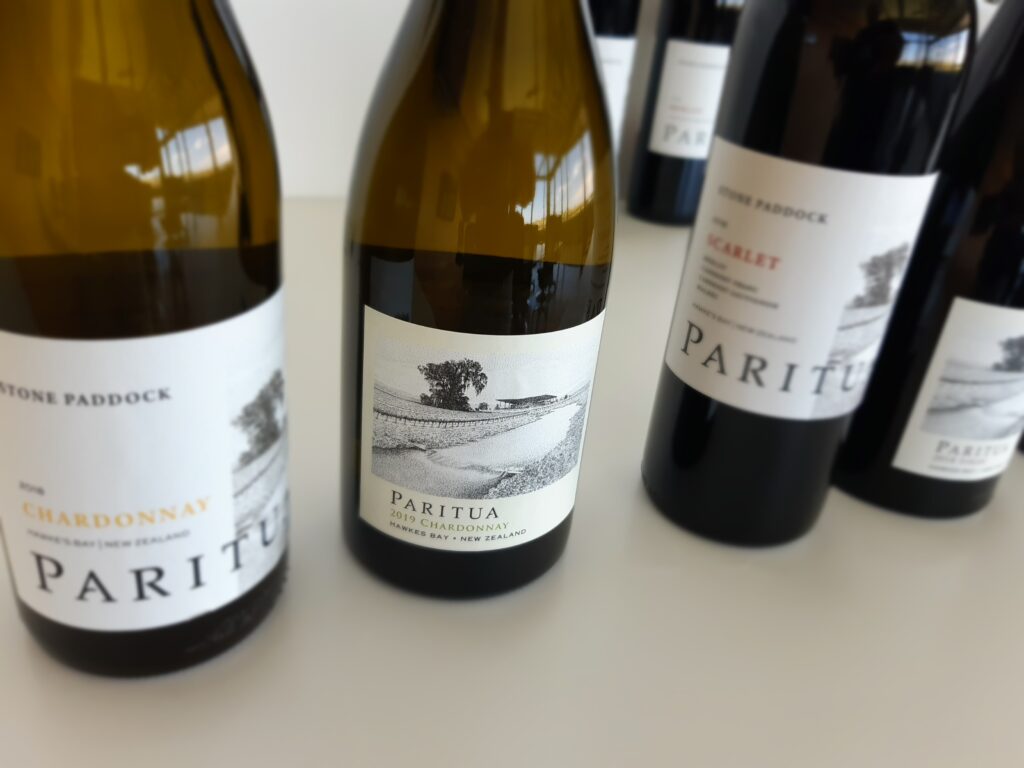
As Jason says – “It makes all the difference, absolutely. You get excited about sending them wines because they’re keen”.
The Paritua Chardonnay has about 50% malolactic fermentation, and this vintage had about 40% new oak. The oak they like to use is medium toast, and a low impact tannin kind of oak. Jason comments that they are quite specific about the oak: “It’s been dried in a specific way and usually two to three year drying age.
We use the coopers where the options are that the way the oak is stacked a lot of the tannin is washed out, but not the aromatic component. And we don’t have any toasted heads in our chardonnay, syrah or red barrels. It helps lift the aroma and I prefer that”.
The Paritua Chardonnay is a classic Hawke’s Bay style. It’s not gone into that super reductive style. They look to retain the fruit character, keeping that citrus and stonefruit that I think you get from Bridge Pa soils. It is quite warm there and heat is retained in the evenings which can drop the acid quite a bit – often the picking is done a little bit earlier than elsewhere in the region.
Ten years ago they might have have been picking around 24 brix, but that’s been pulled back as they try to aim for around 13% alcohol. That’s picking around 23 brix but looking to pick on flavour. With their vineyards literally on the doorstep, that makes the job a good deal easier. Anyone can look at the numbers but the main factor should always be flavour.
Our thoughts turn to vineyard management, and irrigation – it’s been a funny few days of weather before I visit. Jason tells me about something new that’s being trialled at Paritua. “We’re trying different methods for irrigation – like deficit irrigation, where instead of irrigating every few days, or a few hours every second day, we use a machine and a leaf sample and monitor it that way”.
I pose the question (one of my classic ones… bear with me) whether the science has helped – that it’s come along at a time when New Zealand wine is ready to take on the world?
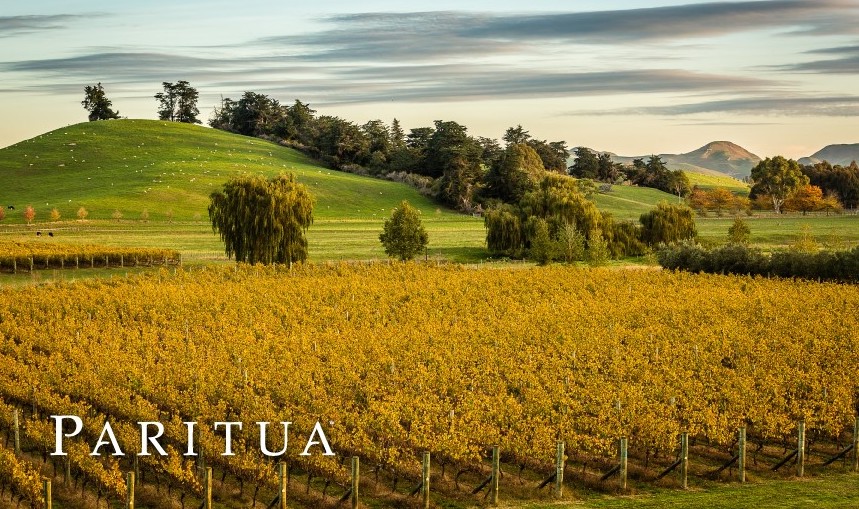
Jason: “The thing with the irrigation system is that weren’t not overwatering, not giving the vine water when it doesn’t need it. Trying to keep the curve slowly going down on a nice angle. Not too sharp, not too high. We’ll see when we’ve had a rain event – the graph has a spike in it. The whole method of irrigating this way is so it’s more like actual rain events.
And we have the stream that goes through the property. ‘Paritua’ means ‘the stream over the ancient river bed’ or it can mean ‘the stream from the ancient cliff’. Over there in that white shed is also our frost fighting pumps. The stream is charged by a dam just up the road, and we can open a gate and flood the stream.
We have to do that about four hours before an event, and when we have a frost we spray the whole vineyard with water and as the water freezes it gives off heat to the vine and into the atmosphere. Every time we do it it’s a case of putting on a millimetre of water every hour, so a ten hour frost event is like having 10mm of rain. But it’s a really good tool and we’re very lucky to have it. The original owners were worried about these power lines that run right across the vineyard, if we had to use helicopters. They had just bought this land after the November 2002 frost which was extremely late and wiped out most of the crops in Hawke’s Bay. And they didn’t want to use frost fans, because the fans didn’t work in that event – there was no inversion layer. So they wanted to use water and there’s a source right there, so it made sense”.
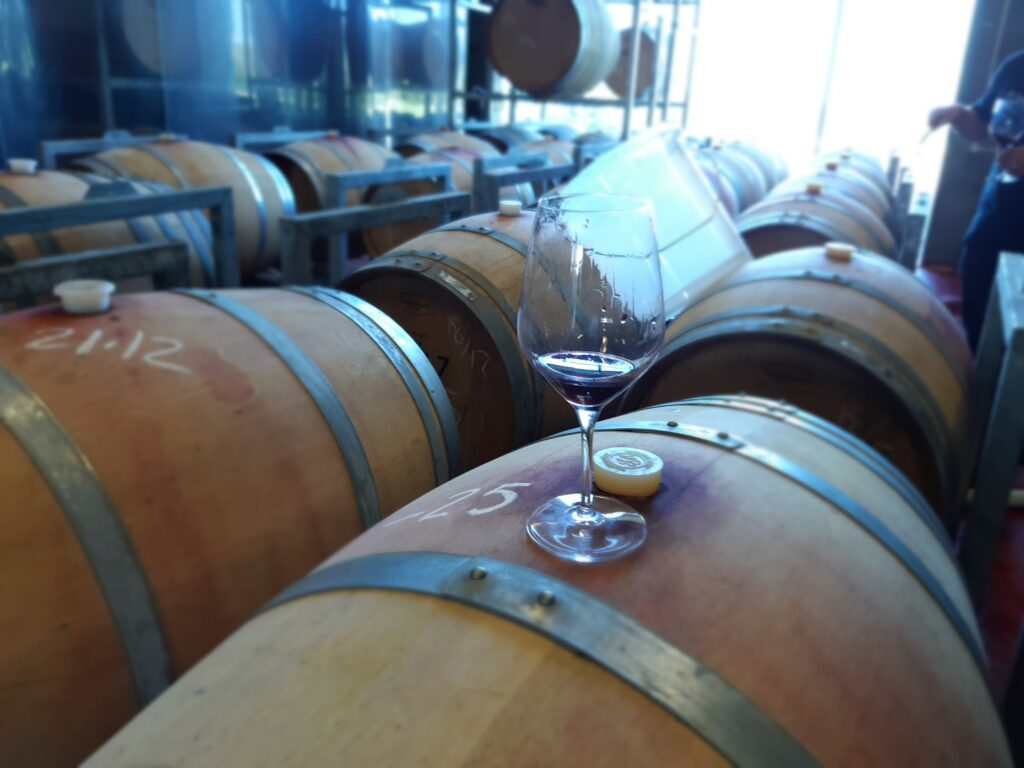
I see Hawke’s Bay as a ‘fine wine region’. For example, Central and Marlborough are very well known for one varietal each; but here there are several excellent types and styles. I see Paritua as a ‘classic’ Hawke’s Bay label, making that ‘Hawke’s Bay style’ of wines. Obviously that will have its cycle of popularity and what’s in vogue. Paritua is now owned by a group of Chinese/kiwi permanent residents and have continued to make the styles they’ve always made.
Aiming for consistency along those lines and not following the latest fashions. They have won trophies and awards in the past but for them it is more about keeping to the style, and then taking the plaudits if they win a medal or a trophy.
Jason sees it this way too: “We’re not the cool kids on the block, but we’re also not trying to be pretentious or anything like that. We honour what the grape gods give us every year and do the best we can with it. We are doing everything we can in the vineyard to achieve the best quality we possibly can”.
Paritua are in conversion to organics – heading towards being fully organic after next year. Looking after the soil and the vines – with a desire to see those vines to still be productive in a hundred years time. Anecdotally, what they are seeing is that the vines are looking healthier and are more resilient when conditions are trying. It has taken its toll a little on crop level during conversion but it is bouncing back. A lot of the vineyard was being run organically as an experiment anyway, but they finally bit the bullet in 2017.
We find three more wines we can have a look at – starting with the ‘Paritua Scarlet’, a blended red that’s merlot-dominant. This 2018 is a nice bright wine. Quite light in colour but with plenty of character. Purple-blue fruit notes and some nice spice in there. More spice than pepper. Elegant and lithe on the palate – with merlot I’m used to that baking spice note, but I get a bit of charred red capsicum, or fennel in this one. Jason thinks it’s possibly because, in that wine, they use a Cab Sav clone called ‘LC-10’ which can have a bit of a jalapeno, chilli element to it. He adds “And there is a lot of wild fennel in the vineyard – maybe with the flowers flying around, you might get an influence in the vines. Over the other side we’ve got a whole lot of gum trees and if there’s any oil in the air, with a northwest wind, that could get into the vineyard. We see it in the chardonnay if anything, because that’s the closest”.
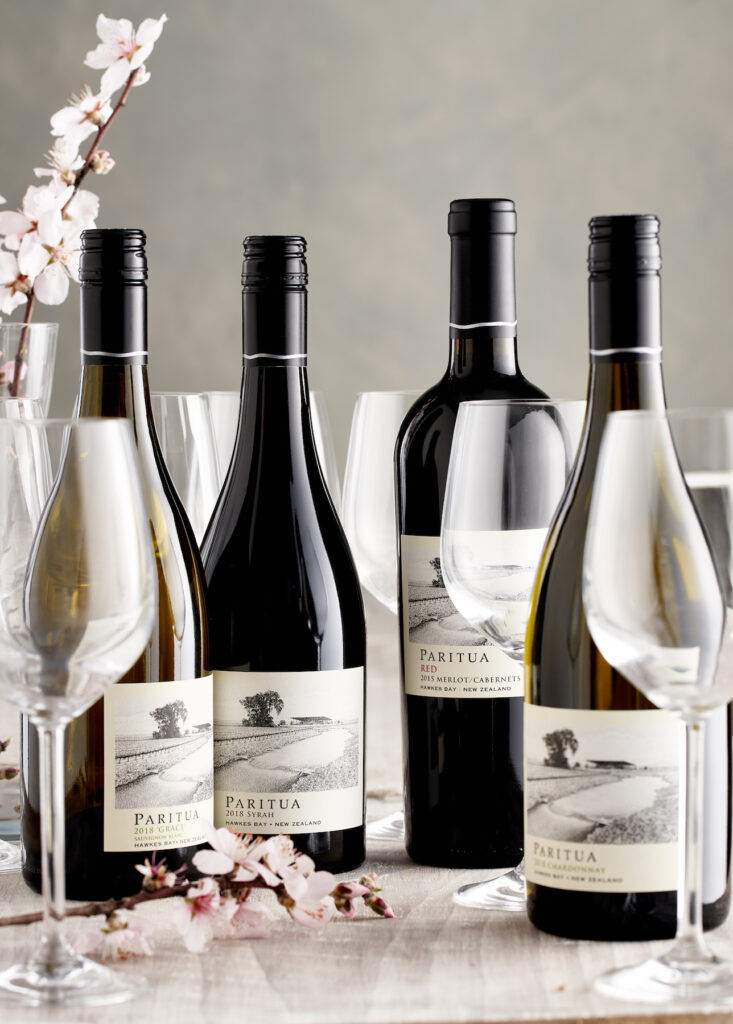
Paritua tend to pick pretty ripe – the ‘Scarlet’ is 14%. It seems that with the different types of irrigation, physiological ripeness is starting to show at lower sugars, so it is possible that over the next 5-10 years the wines may be sitting around 13.5%. The intention is always to still pick on flavour, even if some years are a bit higher in alcohol. All their fruit is grown on the estate. What goes into the ‘Stone Paddock’ range is typically just cropped a bit heavier – around 2.5-3kg per vine depending on the varietal.
Talk turns to the future, and what we think will be the next thing for Hawke’s Bay. I tend to think that Syrah would be the one, but Jason has other ideas.. “I think Albarino could take off. It’s really easy to grow and it’s somewhere in between Riesling and Chenin Blanc, in flavour profile. It’s a really nice drink and I think we could do it really well here. Redmetal down the road does a really awesome one and a few people are doing quite nice ones.
It’s nothing like what you get from Portugal or Spain, but it does have some of those characteristics where it’s got lovely acidity, nice easy drink, when it’s chilled it’s still aromatic and generous. We probably need to do a bit more Syrah, to get a bit more critical mass out there. We could push Cab Franc more – as a single varietal, or a dominant part of a blend. Syrah is one of the most difficult varietals to get the irrigation just right. It grows like a triffid – you leave on the Friday and come back on the Monday and you’re like ‘what happened here?’”
We move on to ’Red’ – their blend, that I’ve loved in the past. Again, it is merlot dominant – as a rule it tends to be. I’m of the opinion that there’s nothing wrong with Hawke’s Bay Merlot. It’s so good that it has been taken for granted. And just perfect for a blend, to hang the other elements off. We both agree that Cabernet Franc is the glue that holds it all together. Because aromatically it just lifts the Cabernet note, and lifts the plumminess of the Merlot.
The ‘Red’ has 40% new oak, and Paritua do all the red wines’ malolactic ferments on skins, with some pretty long macerations. Typically anywhere from four to five weeks, from the time of crushing to the time of pressing. It gets crushed, occasionally with some cold soaking – but most of the time, it is allowed to sit overnight, then, the following day, it gets inoculated. Not too many wild fermentations, although Jason does note that he gets the best results with Malbecs in a wild ferment and “typically we want to get the reds going as quickly as possible. We’re a pretty small team and vintage can start to drag on”.
As I’ve said to a few people on my travels around – my no.1 rule is ‘delicious’. How you get there is not as important to a consumer, but how quickly it’s achieved – that can be important. Increasingly, I think people are looking for wines that are accessible, and not having to be put away for cellaring for a decade before they can be drunk. And I wonder if that sense of ‘immediacy’ is a reflection of the times we live in – with people wanting their needs met instantly, but also the weird year we just had, where people aren’t looking 20 years into the future, but are concerned with ‘right now’?
Jason has a think and has the final word on this: “The thing that we’ve been seeing a lot is some of the wealthier people, who are living a great life now, aren’t looking to put wines down for ten or twenty years and drinking them in the future. They want to smash them now”.

